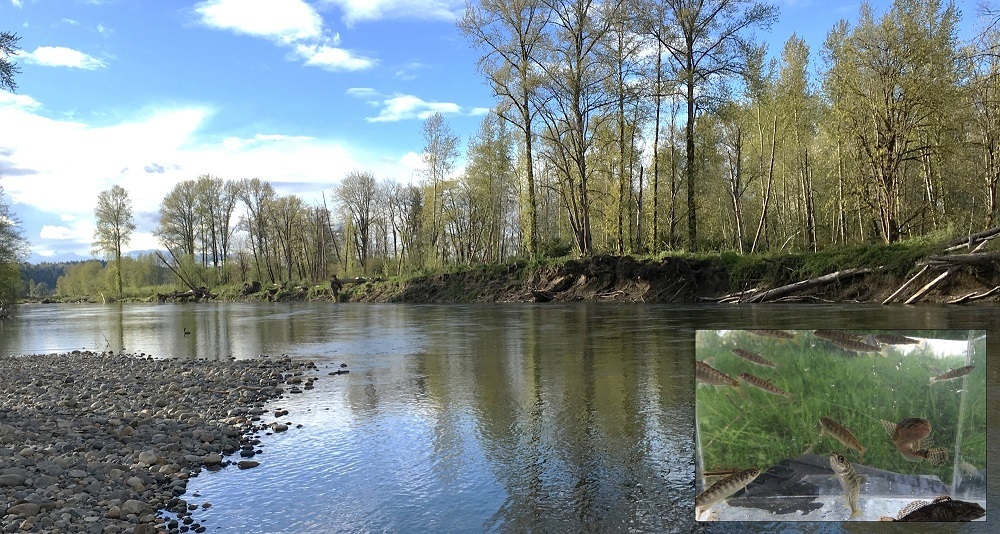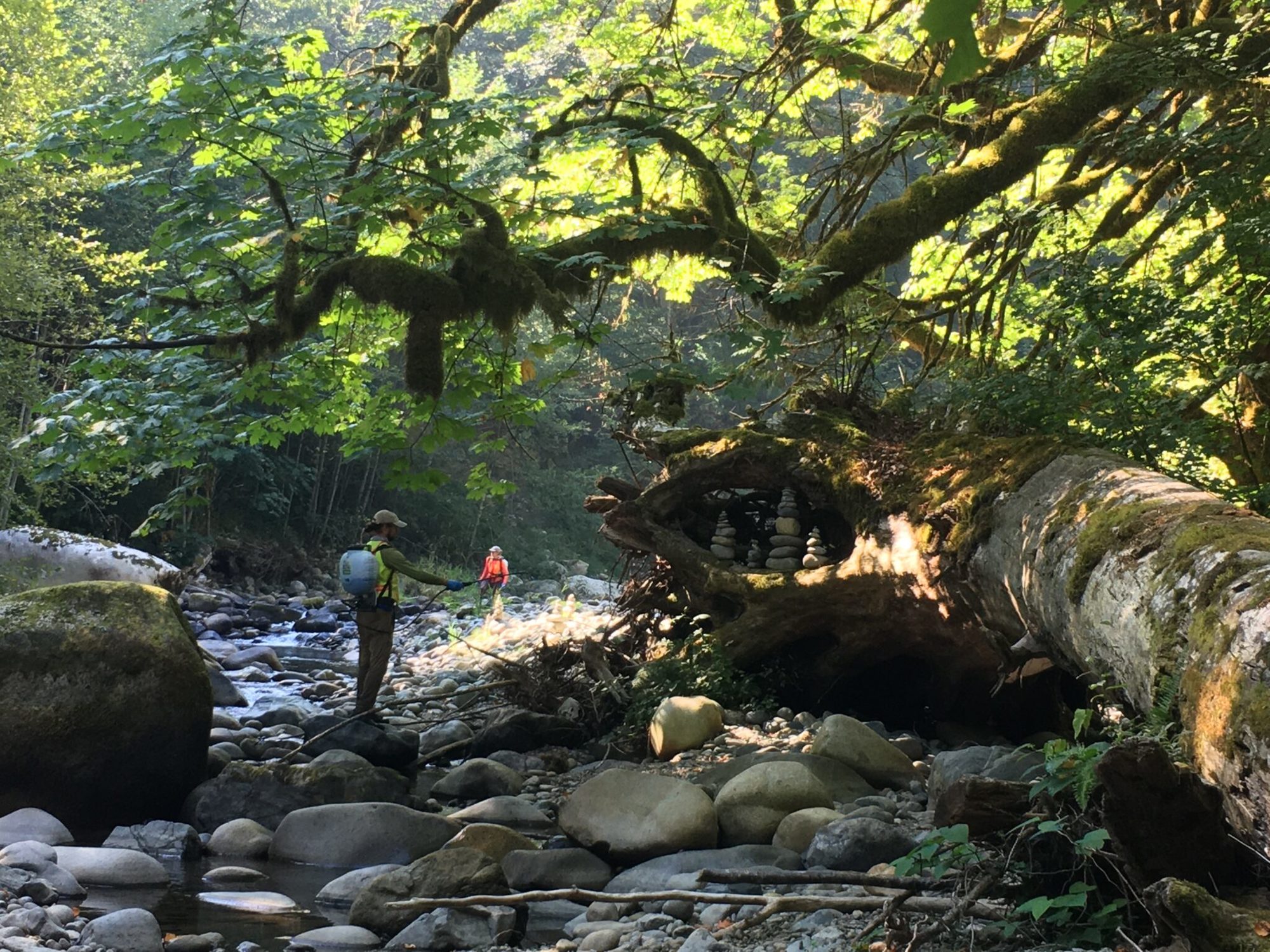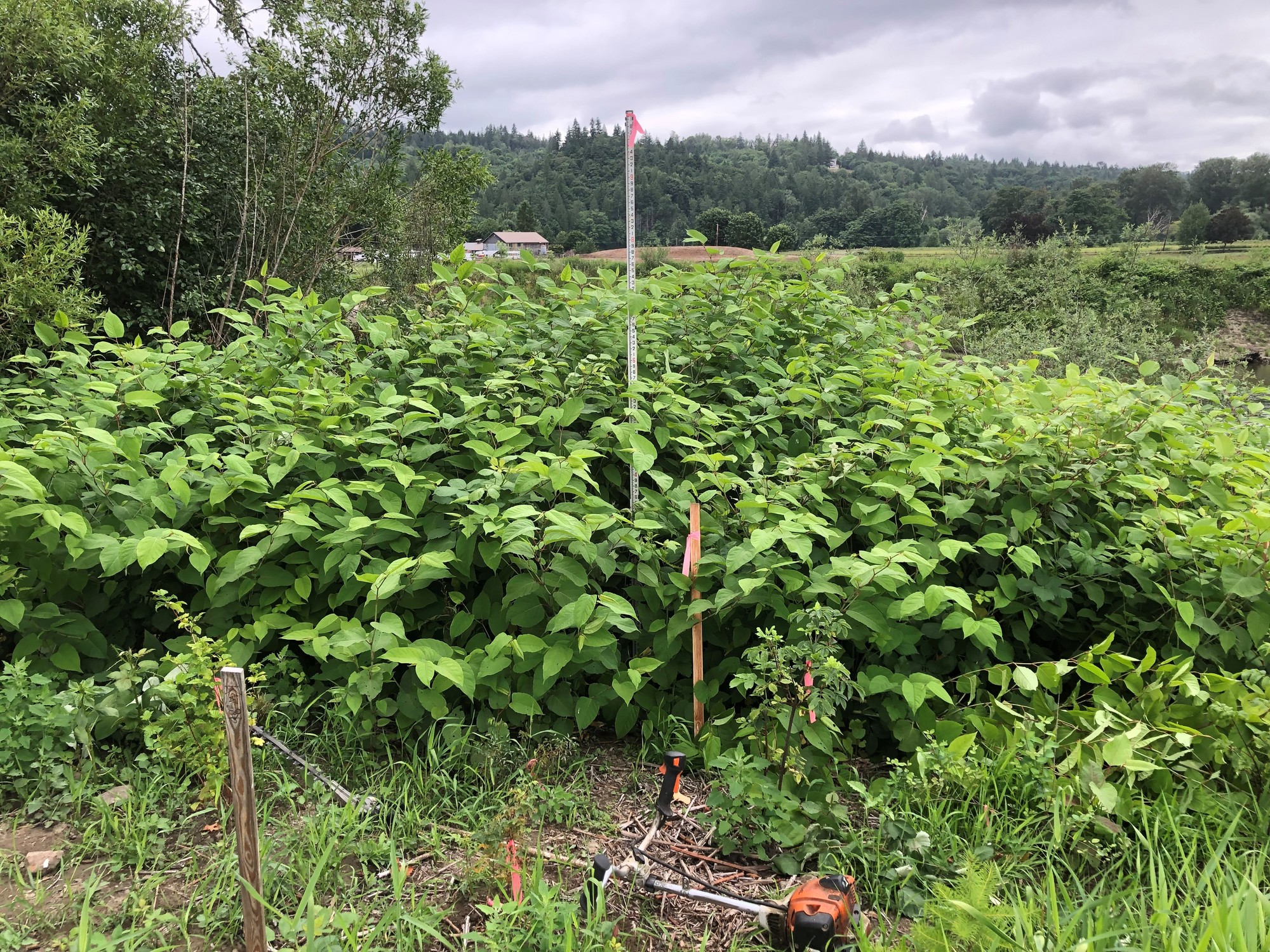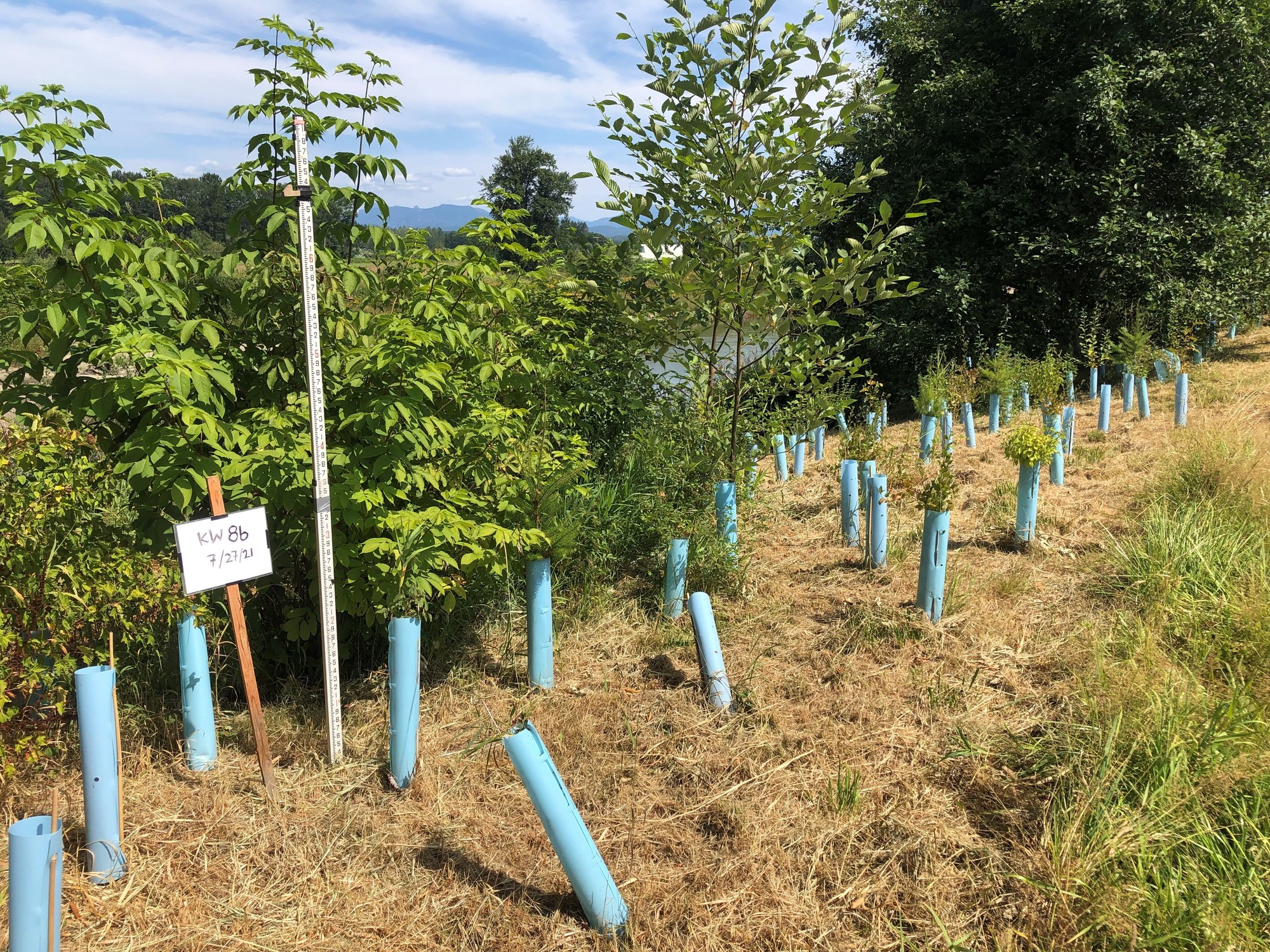What's New in the Snoqualmie Watershed
In this edition...
How Snoqualmie River projects are helping salmon
 |
|
Upper Carlson restoration site, located just downstream of Fall City, and baby fish found nearby by King County scientists.
|
Improving river habitats has been the focus of several large projects across the lower Snoqualmie River. King County’s Science and Technical Support Section conducted a review and analysis of monitoring information from five Snoqualmie River projects to find out if and how projects have improved habitat conditions and if baby salmon have responded.
Results showed that projects have not only improved habitat conditions, but that baby salmon have positively responded to project actions such as removing rock from riverbanks and adding large trees to the river. While all improved habitats can benefit young salmon, if projects aim to maximize habitat improvements, then the restoration of riverine processes will likely be the best approach.
For more details read the report, Snoqualmie River Project Effectiveness Evaluation – Aquatic Habitat and Juvenile Salmonid Observations or contact Josh Kubo, Environmental Scientist, with any questions.
 |
|
Courtesy of Mountains to Sound Greenway Trust.
|
Knotweed removal on the South Fork Snoqualmie River and Raging River
The Mountains to Sound Greenway Trust restoration crew has been hard at work this month tackling knotweed along local rivers. Knotweed erodes creek banks, creates flooding hazards by clogging waterways, displaces native plants, and lowers the quality of habitat for fish and native wildlife. Large infestations can even negatively impact property values for homeowners. The team was working on the Issaquah Creek Basin Knotweed Project earlier in August, where they had the cooperation of more than 130 private landowners and treated more than 65 acres of knotweed. Currently, they are working along the South Fork Snoqualmie River and the Raging River, where they will cover more than 8 river miles and work with over 75 private landowners. For more information, visit the Mountains to Sound Greenway Trust’s knotweed control program page and read their blog post about this project.
Oxbow Farm helps tackle a knotty problem on the Snoqualmie River
 |
 |
|
Beginning knotweed control (2019, left) and after replanting (2021, right) at Oxbow Farm & Conservation Center.
|
Oxbow Farm & Conservation Center has been working with King County Noxious Weed Control Program for 3 years to address the knotty problem of invasive knotweed. The goal of the work (funded by Snoqualmie Watershed Forum’s Cooperative Watershed Management grant program) was to control this invasive plant at Oxbow Farm while restoring native riparian forests in the impacted areas and studying several weed control methods.
Oxbow Farm staff tested the effectiveness of 4 cutting frequencies, fabric covering treatments, and two herbicide formulations for knotweed control, and planted over 2,500 native plants to help bring back riparian forest. Read the findings in this new report on the Oxbow Farm website.
More large wood placed in the South Fork Tolt River
 |
|
Photo courtesy of Seattle City Light.
|
Success! Another 117 full-length logs/trees were installed with a Chinook helicopter in the South Fork Tolt River on July 1. Three trees, exceeding the helicopter’s 25,000-pound capacity, needed to be trimmed before liftoff. Since last fall (see link to video and story in December 2020 newsletter), over 300 trees were placed in 3 days along approximately 6 miles of the river. Jams were placed strategically to facilitate reach-level geomorphic change. This, along with 3–4-piece complexes, will create habitat complexity important to salmon and steelhead spawning and rearing success. Kudos to the Tolt Fish Advisory Committee (TFAC), including Seattle City Light, Seattle Public Utilities, Tulalip Tribes, Washington Department of Fish and Wildlife, US Fish and Wildlife Service, and NOAA Fisheries, who planned and implemented the project as part of mitigation under the City of Seattle’s Tolt Hydroelectric Project FERC License.
Development changes how rain moves across our landscapes: Sign up by Sept. 15 for King County’s new Surface Water Management Fee discount for families with low incomes
Annual property taxes include a fee for surface water management. That fee helps address flooding, erosion and pollution caused by development. If you qualify as a low-income household and live on your own property in unincorporated King County, you may be eligible for a 50 percent discount on the annual Surface Water Management fee on your land parcel(s). Learn more on the county website, call 206-477-4800, or send an email.
Lake Joy Road temporary closures to restore fish passage
The King County Roads Division started construction on a fish passage project on a tributary to Harris Creek under Lake Joy Road on July 19 and will complete that work in early fall. The fish passage field crews observed coho at this culvert last fall and this year the returning fish will find much improved conditions. Find out more at the Lake Joy Road culvert replacement web page.
 |
|
Damaged bridge on Fish Hatchery Road in 2020.
|
Damaged bridge on Fish Hatchery Road removed
The short bridge on Fish Hatchery Road was removed in July after being damaged in a storm in November 2018. The bridge is located along the Snoqualmie River near Fall City and Tokul Creek. The bridge has been closed to car traffic since it was damaged. For more information, see the Fish Hatchery Road bridge web page.
Report dangerous boating or jet ski activity
With warmer summer weather, recreating on the Snoqualmie River is becoming increasingly popular. There are recent reports of jet ski users on the Snoqualmie River traveling at high speeds, creating big wakes, endangering people and causing property damage. While there is no speed limit for boats on the Snoqualmie River, King County Code Section 12.44.040 prohibits negligent operation and Section 12.44.050 deals with reckless operation. The King County Sheriff's Office has begun enhanced enforcement to respond to complaints. Reporting incidents to the Sheriff helps them reach out with education and enforcement. Even when an immediate response is not possible, a record of citizen complaints helps to justify actions like enhanced enforcement in a particular area.
To report an incident:
1) If it is currently occurring, call 911 and provide as many details about the location, vessels, and activities as possible.
2) If no longer an active incident, call the Sheriff’s non-emergency line at (206) 296-3311, or use the on-line reporting tool. Select “Suspicious Circumstances” and provide a description. Please indicate if you have photos, vessel numbers or other additional information.
WRIA 7 Watershed Streamflow Restoration Plan
Tremendous collaborative work was accomplished in the past two and a half years in developing the WRIA 7 watershed plan, says Ingria Jones from the Department of Ecology. However, the WRIA 7 Watershed Restoration and Enhancement Committee did not reach a consensus on approving the plan. Ecology will build upon the committee’s work and finalize the WRIA 7 watershed plan pursuant to RCW 90.94.030. Please see Ecology’s streamflow restoration planning update for more details about the next steps. To stay updated on future streamflow restoration announcements, consider subscribing to Ecology’s new streamflow restoration ListServ or visit Ecology’s webpage.
Snoqualmie Watershed Forum meetings: informative and open to all
The Snoqualmie Watershed Forum is comprised of 13 members and meets 6 times per year to make decisions about projects and activities that improve the health of the Snoqualmie River and the South Fork Skykomish River in King County. The meetings are open to the public, and the September 15 and November 17 meetings will be held virtually to help prevent the spread of COVID-19. Upcoming meeting topics include new guidance for planting along streams by Washington Department of Fish and Wildlife; the latest on how many adult salmon returned to spawn and how many baby salmon were counted on their way to Puget Sound; and a new map of King County barriers to fish passage and how they will be prioritized for getting fixed. Contact Carla Nelson to be added to the email list to receive meeting agendas or check this Snoqualmie Watershed Forum page for meeting schedules, agendas, and past meeting summaries and presentations.
Events and Conferences
Orca Recovery Day on 10/16/2021. Click this link to register.
Free virtual Climate Summit: On October 6, 2021, the Washington State Office of the Insurance Commissioner is hosting a free online Climate Summit. Speakers will highlight the latest climate science, private sector best practices, and regulatory environments related to climate change. Click the registration link to join.
Funding Opportunities
FEMA BRIC / FMA Grant Programs
FEMA’s two competitive mitigation grant programs – the Building Resilient Infrastructure and Communities (BRIC) and the Flood Mitigation Assistance Grant - provide states, local communities, tribes and territories funding for eligible mitigation activities. Priorities for this year are projects that incentivize natural hazard risk reduction activities that mitigate risk to public infrastructure, prioritize benefits to disadvantaged communities, mitigate risk to one or more community lifelines, incorporate nature-based solutions, and enhance climate resilience and adaptation. Learn more about eligibility, cost-shares and more on FEMA’s website.
Note that this grant program requires engagement with both Washington State Emergency Management Division (EMD) and FEMA. A Pre-Application must be submitted to the WA State EMD no later than COB on Tuesday, September 7, 2021. Pre-Applications must be submitted using the appropriate form(s) provided by EMD and sent to HMA@mil.wa.gov (contact this address for the form). Sub-applicants who do not submit a pre-application form by COB September 7, 2021 will not be eligible to submit full applications for the grant program.
Water Quality Combined Funding Program
Ecology's Water Quality Combined Funding Program (WQC) provides annual funding to projects that improve and protect water quality throughout Washington. Applications for funding in this cycle are accepted from mid-August to mid-October of each year.
Eligible projects: Nonpoint source pollution control projects, Stormwater projects, Wastewater projects.
More information: Daniel Thompson.
Flood Control Assistance Account Program (FCAAP) Grants
The Washington Legislature established the Flood Control Assistance Account Program (FCAAP) to assist local jurisdictions with comprehensive floodplain management planning and implementing actions to control flooding. Funding is determined every biennium by the state Legislature. Applications are being accepted from August 3 to September 30, 2021.
Eligible projects: These grants will focus on Comprehensive Flood Hazard Management Plan (CFHMP) updates this year with an emphasis on underserved communities. Technical work to support CFHMP updates will also be eligible.
More information: Scott McKinney
Shoreline Master Program Competitive Grant Pilot Program
The Department of Ecology is offering grant funds to support locally-driven shoreline planning efforts and Shoreline Master Program (SMP) implementation. Learn more about this pilot program here. Applications will be accepted starting September 1 to October 14, 2021.
Eligible projects: Planning and planning-related efforts in the following categories: Local shoreline planning priorities; Enhanced SMP implementation; Sea level rise plan
Eligibility: Washington counties, cities, and towns with a Shoreline Master Program
Funding available: $827,000 total; max award $100,000
More information: Carolyn Chase.
NOAA Climate Program Office
The NOAA Climate Program Office (CPO) is seeking applications for eight individual competitions in FY22. Four climate risk areas of particular interest to CPO are: Coastal Inundation, Marine Ecosystems, Water Resources, and Extreme Heat. Letter of intent due August 9, full applications will be due on October 18.
Eligible projects: Focus on ecological drought and building tribal drought resilience.
More information: Dianne Brown.
Promise the Pod
Promise the Pod's tree credit program is a project working to support restoration projects and Chinook salmon habitat throughout the Pacific Northwest. This work happens through partners at One Tree Planted to get funds to support riparian and post-fire tree planting projects.
If you are in need of supplemental funding for planting any trees or shrubs as a part of your work, you are encouraged to submit an application to this tree credit program through this form. They can offer a maximum of 0.80 cents per plant, although sometimes payment is lower. They are just wrapping up funding for 2021 (accepting submissions until September 1st), but will also have funding available in 2022. If tree planting has already started, they can fund any plants that were planted in 2021. They advise that for most partners this is best leveraged on top of other funding you have to support the numerous actions required to prepare for, conduct and maintain plantings.
More information: Hannah Buehler.
Salmon and Orca in the News
King County’s young noxious weed hunting hero
Fish and Wildlife warns against building dams on local rivers
‘These lands are being loved to death:’ Snoqualmie Tribe educates residents about ancestral lands'
The “Recreation Boom” on Public Lands in Western Washington: Impacts to Wildlife and Implications for Treaty Tribes
Taking the temperature of salmon
Ace Hardware fined for polluting Snoqualmie River
North Bend’s water conservation ordinance effective August 15
Data shows Snoqualmie is one of Washington’s fastest growing cities
And, as always, remember that the beautiful "From Mt. Si to Wild Sky" watershed posters — featuring the photography of talented Valley residents — are available FREE from Carla Nelson or by calling 206-263-3050.
The Snoqualmie Watershed Forum works to protect and restore the health of the SF Skykomish and Snoqualmie Watersheds in harmony with the cultural and community needs of the Valley.
If you would like to be added or removed from the Snoqualmie Watershed Forum mailing list, or if you would like to submit an item for inclusion in the next Snoqualmie Watershed Forum e-newsletter, please contact Carla Nelson.
Funding for this publication is provided by King County Flood Control District.
|